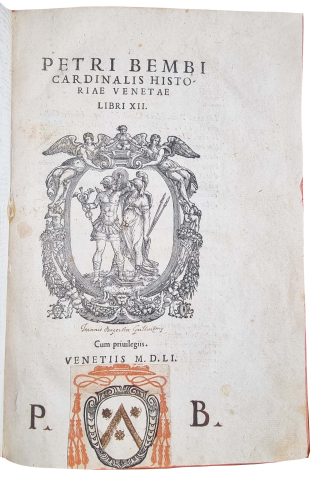BEMBO, Pietro.
BEMBO’S COPY?
Historiae Venetae Libri XII.
Venice, [apud Aldi filios], 1551.£6,750.00
FIRST EDITION, second state. Folio. ff. [4], 203, [1, errata]. Woodcut device to title, Aldine device to last verso, decorated initials and ornaments. Light age yellowing, the odd marginal thumb mark, small oil stain to last two ll. An excellent, clean, very wide-margined copy, on high-quality paper, in c1700 sheep, marbled eps, spine gilt, gilt-lettered morocco label, C18 bookplate of Vincenzo Maria Carafa Cantelmo Stuart (1739-1814), Prince of Roccella, and C20 bookplate of Miquel Boix Carreras to front pastedown. C16 autograph Joannis Baptistae Grillinzonij, to title above C16 paper slip with red printed cardinal’s galero and tassels surrounding woodcut shield pasted over, Bembo’s arms inked within, ms initials PB to title, occasional C16 Italian ms marginalia.
The woodcut frame with the ms arms and initials of Cardinal Bembo is curious. We have not found any other example. A link between the Grillenzoni and Bembo is Lodovico Castelvetro, who was known to both, wrote a commentary to Bembo’s ‘Prose’, and lived in Modena until 1553. The woodcut frame is C16 in style, and was not infrequently used by prelates of the time. The bleeding from the edge paint shows it was there before the current binding. It is possible that these were added by the author to his own copy of the text, it is equally possible they were added by or for a friend or admirer, maybe the known early owner Grillenzoni which is consistent with the presentation quality of the copy. It is unlikely they are either accidental or a deliberate attempt at faking at such an early date.
A clean, well-margined copy of the first edition of Pietro Bembo’s ‘History of Venice’ – ‘the culmination of Venice’s official historiography’ (Mazzocco) – with a chapter on the discovery of America and Portuguese eastern expeditions. Cardinal Bembo (1470-1547) was a major poet and scholar, whose ‘Prose della volgar lingua’ greatly influenced the development of Tuscan as a literary language, rekindling interest in Petrarch and Dante. Bembo wrote ‘Historiae Venetae’ – a history of Venice from 1487 to 1513 – as official historiographer of the Serenissima; he also made an Italian translation, both were published after his death. Bembo was granted permission to consult ‘material of the chancellery, the books of the secret affairs, and the records of the deliberations of the Council of Ten’ (Mazzocco, pp.99-100). Book VI includes a 5-page narrative of Columbus’s travels and discoveries till 1502, prefaced by a summary of cosmographical theories of the time and how Columbus’s ideas differed. This is followed by a section on Portuguese discoveries including Magellan’s travels, in Africa (Cape of Good Hope) and Asia. Book VII features what may be the first description of Eskimos (though not so called) – ‘short, of a darkish complexion, with clothes made of fish skin, who ate raw meat and drank blood’ – found stranded on a wicket boat off the English coast.
The late C16 annotator – Giovanni Battista Grillenzoni – glossed ‘Columbus’ and ‘Maglaianes’ (Magellan) on the margin. He translated some of Bembo’s Latin into Italian, in marginal glosses. Grillenzoni was a member of the major Modenese family; two more books from his library – Medina’s ‘Arte del Navegar’ (1554) and Magini’s ‘Ephemerides’ (1582) – are preserved at the Bib. Estense, in Modena.
Renouard 263:5; Ahmanson-Murphy 420; BM STC It., p.80; Adams B597; Alden 551/8; Sabin 4619. C. H. Clough, ‘Pietro Bembo’s L’Histoire du nouveau monde’, BLJ, 4 (1978), pp.8-21; A. Mazzocco, ‘Humanistic Historiography in Venice’, in A New Sense of the Past (2016), pp.89-104; M. Danzi, La Biblioteca del Cardinal Pietro Bembo (2005); M. Al Kalak, L’eresia dei fratelli. Una comunità eterodossa nella Modena del Cinquecento (2011).In stock





